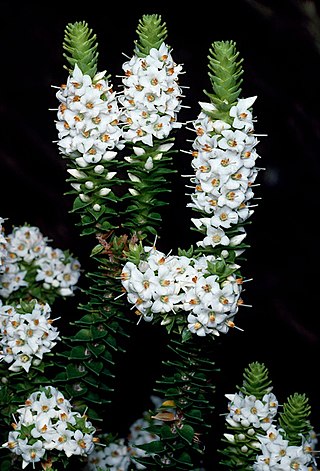
Linum lewisii is a perennial plant in the family Linaceae, native to western North America from Alaska south to Baja California, and from the Pacific Coast east to the Mississippi River. It grows on ridges and dry slopes, from sea level in the north up to 11,000 feet in the Sierra Nevada.

Nervilia concolor, commonly known as the tall shield orchid and as Nervilia aragoana in Australia is a small terrestrial orchid found in South and Southeast Asia and in northern Australia. It has pale green, short-lived flowers with a cream-coloured or yellowish labellum and a more or less circular leaf which emerges at the base of the flowering stem after flowering.

Dianella revoluta, commonly known as blueberry lily, blue flax-lily, or black-anther flax-lily, a species of flowering plant in the family Asphodelaceae and is endemic to, and widespread in Australia. It is a tufted, perennial herb with grass-like leaves and up to nine blue or violet flowers with six tepals, and stamens with bright yellow filaments and pale brown to almost black anthers.

Bossiaea buxifolia, commonly known as matted bossiaea, is a species of flowering plant in the family Fabaceae and is endemic to south-eastern Australia. It is a prostrate to weakly erect shrub with elliptic to egg-shaped or almost round leaves and yellow, red and purplish flowers.

Dillwynia sericea, commonly known as showy parrot-pea, is a species of flowering plant in the family Fabaceae and is endemic to south-eastern Australia. It is an erect to low-lying shrub with hairy stems, linear leaves and apricot-coloured flowers, usually with a red centre.

Bossiaea foliosa, commonly known as leafy bossiaea, is a species of flowering plant in the family Fabaceae and is endemic to south-eastern Australia. It is an erect shrub with small, broadly egg-shaped to round leaves, and bright yellow flowers.

Dillwynia phylicoides, commonly known as small-leaf parrot-pea, is a species of flowering plant in the family Fabaceae and is endemic to eastern Australia. It is an erect to open shrub with twisted, linear to narrow oblong leaves, and yellow and red flowers.

Pterostylis hildae, commonly known as the rainforest greenhood, is a species of orchid found in eastern Australia. It has a rosette of leaves and when flowering a rosette at the base of a flowering stem with a single green, white and brown flower. It is found in wet forests, including rainforest in New South Wales and Queensland.

Thelymitra venosa, commonly known as the large veined sun orchid, is a species of orchid that is endemic to New South Wales. It has a single fleshy, channelled leaf and up to six relatively large, bright-blue flowers with darker veins. The arms on the side of the column are twisted and yellow, but not toothed at the tip. Unlike most other thelymitras, the flowers do not usually close on cloudy days.

Leptospermum multicaule, commonly known as the silver tea-tree, is a species of shrub that is endemic to south eastern Australia. It has linear, narrow elliptical or narrow egg-shaped leaves, white or pink flowers usually borne singly on short side shoots, and fruit the falls from the plant soon after the seeds are released.
Philotheca obovalis is a species of flowering plant in the family Rutaceae and is endemic to New South Wales. It is a small shrub with broadly egg-shaped to heart-shaped leaves with the narrower end towards the base, and white flowers tinged with pink and arranged singly in leaf axils.

Goodenia coerulea is a species of flowering plant in the family Goodeniaceae and is endemic to the south-west of Western Australia. It is an erect, perennial shrub or biennial herb shrub with linear leaves at the base of the plant, sometimes with a few teeth on the edges, racemes of blue flowers and oval fruit.

Goodenia gracilis, commonly known as slender goodenia, is a species of flowering plant in the family Goodeniaceae and is endemic to Australia. It is an annual or perennial herb with linear to lance-shaped leaves and racemes of yellow flowers.

Goodenia rotundifolia is a species of flowering plant in the family Goodeniaceae and is endemic to eastern Australia. It is a prostrate to erect perennial herb with more or less round, toothed leaves and racemes of yellow flowers.
Pultenaea canescens, commonly known as plumed bush-pea, is a species of flowering plant in the family Fabaceae and is endemic to a small area in eastern New South Wales. It is an erect shrub with narrow elliptic to narrow egg-shaped leaves, and yellow to orange flowers with reddish-brown markings.

Pultenaea polifolia, commonly known as dusky bush-pea, is a species of flowering plant in the family Fabaceae and is endemic to south-eastern continental Australia. It is an erect to prostrate shrub with linear or elliptic to egg-shaped leaves with the narrower end towards the base, and yellow to orange and red to purple flowers.

Pultenaea procumbens, commonly known as heathy bush-pea, is a species of flowering plant in the family Fabaceae and is endemic to south-eastern continental Australia. It is a low-lying or spreading shrub with lance-shaped or rhombic leaves and yellow, orange and red flowers.

Pomaderris andromedifolia is a species of flowering plant in the family Rhamnaceae and is endemic to south-eastern continental Australia. It is a shrub with lance-shaped to elliptic leaves and cream-coloured to yellow flowers.

Pomaderris ledifolia, commonly known as Sydney pomaderris, is a species of flowering plant in the family Rhamnaceae and is endemic to south-eastern continental Australia. It is an erect, delicate shrub with hairy young stems, narrowly elliptic to lance-shaped leaves, and compact clusters of yellow flowers.

Epacris apiculata is a species of flowering plant in the heath family Ericaceae and is endemic to a small area of New South Wales. It is a small, slender, low-lying to erect shrub with hairy branchlets, egg-shaped leaves with a thickened, pointed tip and tube-shaped flowers with white petals.


















